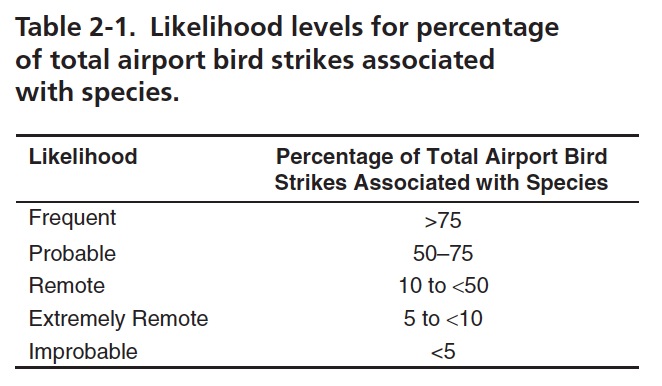TRANSPORTATION RESEARCH BOARD
 Airports are subject to a variety of environmental requirements that drive the need for stormwater best management practices (BMPs) to control the quantity and quality of stormwater discharging from their property. The U.S. Federal Clean Water Act of 1972 (with its subsequent amendments) identified the need to address water quality issues, which led to the implementation of federal, state, and local regulatory programs requiring the management of stormwater quality and quantity. Airports have historically incorporated BMPs to comply with these requirements, such as stormwater detention ponds and vegetated swales, many of which have exposed open water, vegetation, and other design characteristics that attract wildlife. Research shows that 10 of the 15 bird species most hazardous to aircraft are highly attracted to these types of water features (DeVault et al. 2011).
Airports are subject to a variety of environmental requirements that drive the need for stormwater best management practices (BMPs) to control the quantity and quality of stormwater discharging from their property. The U.S. Federal Clean Water Act of 1972 (with its subsequent amendments) identified the need to address water quality issues, which led to the implementation of federal, state, and local regulatory programs requiring the management of stormwater quality and quantity. Airports have historically incorporated BMPs to comply with these requirements, such as stormwater detention ponds and vegetated swales, many of which have exposed open water, vegetation, and other design characteristics that attract wildlife. Research shows that 10 of the 15 bird species most hazardous to aircraft are highly attracted to these types of water features (DeVault et al. 2011).
To address this hazardous wildlife concern, the FAA has established guidelines for airport stormwater management to provide for aircraft safety. These guidelines promote drainage of water away from movement areas as quickly and efficiently as possible, minimizing the attraction of hazardous wildlife species. Airports are challenged with implementing required stormwater BMPs while ensuring the safety of aircraft operations in accordance with FAA advisory circulars (ACs) and Federal Aviation Regulations (FARs). Bird Strike Risk Analysis and Stormwater Management Decision Tool is available on the accompanying CD and is intended to assist airports with evaluating opportunities to balance stormwater management and bird strike hazard management for water-dependent bird species.
Each airport is unique and highly variable in operations, land availability, and local regulatory requirements for stormwater management. Airports need to balance aviation growth and development with resource management while minimizing public safety risk. This tool provides airport personnel with a means of assessing the potential risk of a bird strike associated with a current or proposed stormwater BMP following the FAA protocols for Aviation Safety Management Systems (SMS).
The tool assesses risk as a product of severity and likelihood. The risk of a bird strike is assumed to increase if the severity (extent of aircraft damage) or likelihood of a strike increases. Strike severity is affected by the size or number of birds struck. Research indicates that the following factors affect severity: relative hazard score of a particular species, the perimeter irregularity of the stormwater design, the slope to the water’s edge, the proximity of water bodies to each other, and the percentage of vegetation coverage within the stormwater pond. The likelihood of a strike is affected by the history of bird observations, the proximity of those sightings to the movement areas, the species strike history, and the proximity of the stormwater BMP to the movement areas.
This tool also examines how existing mitigation strategies and additional techniques may be used to mitigate bird strike risk. The risk analysis portion of the tool takes the above data and calculates an overall risk. The stormwater management decision portion of the tool provides a framework for considering wildlife risk, along with other influential factors, into the decision-making process when managing existing BMPs and selecting new BMPs.
Download full version (PDF): Balancing Airport Stormwater and Bird Hazard Management
About the Transportation Research Board
www.trb.org
The mission of the Transportation Research Board is to provide leadership in transportation innovation and progress through research and information exchange, conducted within a setting that is objective, interdisciplinary, and multimodal.
Tags: airports, Bird Hazards, National Academies, stormwater, Transportation Research Board, TRB, wildlife






 RSS Feed
RSS Feed